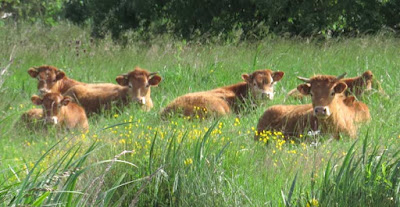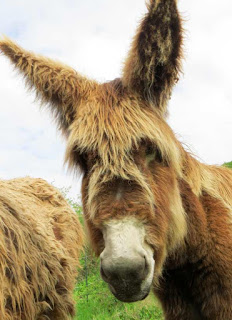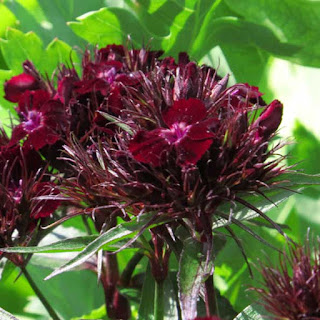"It is necessary to write, if the days are not to slip emptily by.
How else indeed to clap the net over the butterfly of the moment?"
-Vita Sackville West
 |
| Cattle relaxing amongst buttercups on the marais |
Despite ravages of wind and rain which drive us mad with their unseasonal frequency, we find the cattle have arrived back in their summer pasture, sensibly staying together in a sheltered corner. The sheep, too, are back on their hillside and a few more horses have been quartered out on the marais.
 |
| A 'baudet' or Poitou donkey |
Three female Poitou donkeys, which were put out to graze on a hillside early this year, are still in residence but starting to look somewhat bored with their well-chomped meadow.
Their huge size and appealing shagginess contrast with their delicate little feet and gentle natures. Once it starts to really warm up, I fear there isn't much in the way of shelter for them and it must get tiring standing on a slope all day.
Ah well, we've given up trying to understand animal husbandry as practised locally...
 |
| Bee Orchid (Ophrys scolopax) |
Orchids
The grassland surrounding these donkeys is full of pyramid orchids but it's difficult to tell whether they're tempted to munch any which might grow within their electrified enclosure.
The grassland surrounding these donkeys is full of pyramid orchids but it's difficult to tell whether they're tempted to munch any which might grow within their electrified enclosure.
Elsewhere, after seeing a profusion of large 'pyramids' growing along the verges, we came across this pretty array of bee orchids, some of which are noticeably paler than the usual pinkish-mauve. Our damp weather has certainly favoured the orchid colonies and they seem to have spread more widely.
 |
| Orlaya grandiflora with foxgloves and Anchusa azurea behind |
Meanwhile our own home-grown "meadow" is coming along nicely under the medlar tree. In the background a pale pink cistus is just coming into bloom, along with a yellow evening primrose and some geum in the forefront.
New plants from seed
New plants from seed
It's quite satisfying to think that most of the above - save for that geum and cistus - have been grown from seed, all of it supplied by those nice folk at Chiltern Seeds.
The latest batch are growing well, having been moved from their cold frame and hardened-off on a table in semi-shade. These are mostly perennials like veronica, scabious and rudbeckia.
When it comes to potting up seedlings and cuttings, it's amazing how much you can fit into a tight area with careful arrangement of pots and trays. Using a black bin for compost and painting tables and raised-beds in black, helps to keep them uniform and fairly unobtrusive.
As mentioned earlier this month, the sweet williams called 'Sooty' have delightfully spiky foliage and really stand out against the enveloping tide of green.
Their ruby-velvet flower clusters are just starting to open and are seen here against a background of Romneya - a perennial white poppy from California which is already showing fat buds.
Enlarging on the dark theme, I'm currently growing some black antirrhinums to provide additional drama next spring!
Flowers for cutting
When it comes to potting up seedlings and cuttings, it's amazing how much you can fit into a tight area with careful arrangement of pots and trays. Using a black bin for compost and painting tables and raised-beds in black, helps to keep them uniform and fairly unobtrusive.
 |
| Dianthus barbatus 'Sooty' |
Their ruby-velvet flower clusters are just starting to open and are seen here against a background of Romneya - a perennial white poppy from California which is already showing fat buds.
Enlarging on the dark theme, I'm currently growing some black antirrhinums to provide additional drama next spring!
Flowers for cutting
 |
| Spring selection of columbines, foxglove and orlaya |
The above illustrates how dark foliage and flowers provide contrast in a vase. Bronzy-red leaves and stem belong to Penstemon digitalis 'Husker Red', whilst the left-hand cluster is our aforementioned 'Sooty'.
We have a continual parade of pink, apricot and white foxgloves, some of which suffered from snail damage early on, reducing the size of their stems but giving us more flower stalks per plant. Even though a few of these are bent out of shape, they're still a useful length for popping into a jug or vase - it's worth docking a few plants just for this purpose!
 |
Pinks give us a never-ending supply of blooms which last well in water and look particularly fetching with a combination of orlaya and wild allium. These pink-tinged white onion flowers grow in grassy meadows and waysides but fortunately don't smell when picked.
French cottage garden
A neighbouring village held its annual flower show the other weekend and I couldn't resist photographing one of the local front gardens which was attracting much interest from passers-by.
I love the cascade of snow-in-summer and I'm sure all that lily-of-the-valley on the other side will smell wonderful, but I can't help wondering if anything else will happen when all that flowering is finished?
Whereas English gardeners enjoy a parade of flowers from early spring through to late autumn, I've noticed that some local people rely on just a few plant types and may even, for instance, use multiples of the same rose - something that probably originates with formal French gardening in days gone by.
When it comes to cottage gardens, they don't come much more 'bijou' than the little raised-bed in front of our studio (aka the old pigsty).
Its well-drained sandy soil is good for sun-lovers like dianthus and cistus, but we've been particularly surprised at how much the mauve scabious and Lavandula dentata have thrived. They've both been flowering their socks off for weeks, doubtless aided by the frost-free winter.
Bird world
This pretty turtle dove was part of a trio spotted in a nearby vineyard whilst we were out walking. It's quite a rarity in these parts compared with all the collared doves we see feasting on grain from surrounding fields.
At times this place is a total confusion of birdsong, together with warning clucks from anxious parent birds - like the black redstart who takes over the garden as his territory and practically drives our cat demented.
One bird we hear regularly but never see, skulking as it does beside the water-course outside our gate, is the "Chap with the Megaphone" as we used to call him. We finally identified him as Cetti's warbler, who bursts out with the same song every morning: it goes "cheewip - chipper - chipper - chipper - chipper". (And, in case you didn't catch it, he'll happily give you an encore ten minutes later!)
A neighbouring village held its annual flower show the other weekend and I couldn't resist photographing one of the local front gardens which was attracting much interest from passers-by.
I love the cascade of snow-in-summer and I'm sure all that lily-of-the-valley on the other side will smell wonderful, but I can't help wondering if anything else will happen when all that flowering is finished?
Whereas English gardeners enjoy a parade of flowers from early spring through to late autumn, I've noticed that some local people rely on just a few plant types and may even, for instance, use multiples of the same rose - something that probably originates with formal French gardening in days gone by.
 |
| Mediterranean plants grown in a raised bed |
Its well-drained sandy soil is good for sun-lovers like dianthus and cistus, but we've been particularly surprised at how much the mauve scabious and Lavandula dentata have thrived. They've both been flowering their socks off for weeks, doubtless aided by the frost-free winter.
 |
| Turtle dove (Streptopelia turtur) |
This pretty turtle dove was part of a trio spotted in a nearby vineyard whilst we were out walking. It's quite a rarity in these parts compared with all the collared doves we see feasting on grain from surrounding fields.
At times this place is a total confusion of birdsong, together with warning clucks from anxious parent birds - like the black redstart who takes over the garden as his territory and practically drives our cat demented.
One bird we hear regularly but never see, skulking as it does beside the water-course outside our gate, is the "Chap with the Megaphone" as we used to call him. We finally identified him as Cetti's warbler, who bursts out with the same song every morning: it goes "cheewip - chipper - chipper - chipper - chipper". (And, in case you didn't catch it, he'll happily give you an encore ten minutes later!)
 |
| Shelduck babies (Tadorna tadorna) |
Living so near the Gironde Estuary, we quite often see shelducks flying over the marais, usually in pairs. The other morning a couple were repeatedly flying over our garden making a lot of noise, but it wasn't until we ventured out for a walk that we saw these ducklings fast-pedalling up the water channel.
For some reason the adults seemed to be encouraging them from the air rather than 'maman duck' taking a guardian role and leading on the water. Perhaps these parents thought we were posing a threat?
We carried on with our circular walk and were coming back down the hill twenty minutes later when what should we see struggling up the road in front but the intrepid gang of eleven ducklings?
There ensued several heart-in-mouth moments as we signalled oncoming cars to slow down as the little tribe waddled its way uphill... no guessing how many finally made it onto the marais. (We blame those irresponsible parents!)
Finally, a serene sight
 |
| Another French garden - with cleverly matching wisteria and clematis! |


No comments:
Post a Comment